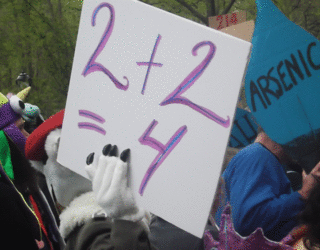Bias
The Discrimination Paradox
Substantial disadvantage results from few acts of discrimination.
Posted September 19, 2021 Reviewed by Gary Drevitch
Key points
- Recent studies show people commit acts of discrimination at very low levels.
- Audit studies find substantial levels of racial discrimination in employment.
- That both are true should inform policies for reducing discrimination, inequality, and injustice.

Recent research has found that only small minorities of people engaged in racial or ethnic discrimination, ranging from a low of 1.3 percent to a high of 20 percent. These numbers are so low, they might be interpreted as something like, "Discrimination is so infrequent as to be trivial." Next, I show, rigorously and mathematically, why that is not justified.
Marginalized Groups Experience Substantial Discrimination
There is no single number for the amount of discrimination a group experiences. Discrimination varies in type (hate crimes, harassment, exclusion, etc.) and, there are many different methods for assessing discrimination, which often yield different estimates.
Still, to illustrate The Discrimination Paradox, I need to use an actual number. How to choose? Some of the most influential investigations of discrimination are called “audit studies.” In these, two candidates who differ demographically, but who are matched for qualifications apply for jobs, college admissions, bank loans, apartment rentals, etc. One of the best single numbers was provided by a meta-analysis of audit studies of racial discrimination in employment (Quillian et al, 2017). Meta-analyses combine results from many studies. The Quillian et al study found that White applicants received, on average, 36 percent more callbacks for jobs than did African Americans, and that the extent of discrimination has not changed over many decades. This is about as credible as an estimate of discrimination gets (though go here for critical analysis of audit studies).
Resolving the Paradox
If acts of discrimination are rare, how does one get a 36 percent advantage for White applicants? In the following examples, White applicants have a 36 percent advantage even though discrimination only occurs 0.6 percent to 3.6 percent of the time.
Let’s say people apply for 236 jobs, and that there are 500 White applicants and 500 Black applicants.
Applying Quillian et al’s findings, in this case:
White applicants would receive 136 callbacks — and Black applicants would receive 100 callbacks.

Whites received 36 more callbacks than did Black applicants, reflecting the 36 percent advantage that White applicants have. That, however, means that acts of discrimination occurred 36 out of 1000 times, or 3.6 percent of the time.
This next analysis is more realistic. Black people are about one-fifth as numerous as White people in the U.S. So let's assume 200 Black applicants and 1000 White applicants, and let's assume 10 percent of Black applicants receive callbacks, so that equals 20 (of 200).
Based on Quilllian et al (2017), White applicants receive callbacks at a rate 36 percent higher than that of Black applicants, which would mean, in this example, that 13.6 percent of White applicants receive callbacks; 13.6 percent of 1000 equals 136. In this example, there are a total of 156 callbacks (20 Black callbacks and 136 White callbacks).
How much discrimination is there? In this example, 13 percent of all applicants receive callbacks (156/1200=13 percent). In the absence of discrimination, this 13 percent rate would be identical for Black and White applicants. This means there would be 26 Black callbacks and 130 White callbacks. In this example, there are six more callbacks for White applicants due to discrimination (136-130=6) which translates to six fewer callbacks for Black applicants. 6/1000 = 0.6 percent. Discrimination occurs less than one percent of the time and yet still produces 36 percent White favoritism.
Why You Should Care
This has important implications for social justice. It may help inform (along with other information) what is more versus less likely to work.

Diversity training (Devine & Ash, 2022) and implicit bias training are not likely to accomplish very much, because there are very few potential perpetrators of prejudice to matter. Hardcore bigots represent 5-20 percent of the population in pretty much every survey ever conducted (such as here and here), and such trainings are not likely to change their behavior. The recent studies described here found discrimination frequencies in the range of 1-20%. It also seems like a colossal waste of human time and effort if 80-99 percent of those subjected to such trainings are already not engaging in discrimination.
Preferential selection can ensure any level of representation desired, but most people, including most members of the minority groups that it is supposed to benefit, oppose it because few support discrimination to end discrimination. This may help explain why California, a state with only a minority of White voters, has twice voted to support referenda banning this type of affirmative action.
Affirmative action other than preferential selection includes things such as providing extra mentorship, outreach to minority communities and organizations, and eliminating known barriers to advancement. Given the importance of schooling, interventions that succeed at keeping students from marginalized groups in school are also likely valuable.
Diversity managers work. These are administrators tasked with overseeing embrace of diversity within in an organization and, because they provide expertise, information, and accountability, the evidence is that having such managers generally succeeds in increasing organizational diversity.

Financial literacy. This appears in almost no social justice interventions of which I am aware, and I’d speculate that this is because many social justice activists are either financially illiterate or anti-capitalist. Nonetheless, there are two ways to close a wealth gap: One is to take from the rich, say, via taxes. The other is to increase the wealth of those who lack it. Investing in the stock market has a long history of producing wealth, and it does not discriminate (if Microsoft goes up 10 percent for a White investor it also goes up 10 percent for a Black investor). Long-term investing is a well-established way to increase wealth, but it only works if one actually engages in it. Although this is no solution for those living paycheck to paycheck, it is a potentially effective intervention for others. Also, to be clear, this is one potential way to redress the wealth gap without addressing discrimination at all.

Time. This is another unsatisfying response. If Martin Luther King was right in declaring that the “arc of the moral universe is long but it bends towards justice,” then, as the bleak legacy of racial discrimination in the U.S. fades into history, so should patterns of racial inequality and injustice. Reilly’s review is consistent with this analysis, as is the experience of many other groups (e.g., Asians, Irish, Jews) who once experienced extensive discrimination but have gone on to educational and economic achievement that exceed that of many White Americans.
Implications for Public Discourse
1. Denial of discrimination by those accused of belonging to groups that perpetrate it is mostly true. When people deny they personally engage in racial discrimination, the base rates of 80-99% non-discrimination show that, most likely, they are not engaging in "White Fragility" or defensive responses of any kind. The odds are somewhere between 4:1 and 99:1 in favor of the conclusion (absent other information) that they are simply telling the truth.
2. Claims of experiences of discrimination by marginalized groups that substantially exceed the denials of discrimination in point 1 above is also mostly true. Broadsweeping dismissals of such claims as grievance mongering, virtue signaling, or moral grandstanding are also unjustified. In this blog, I have shown how even when acts of discrimination occur less than 1% of the time, from the targets' perspective, experiences of discrimination can be much higher (the specific number I used was 36% but it could be even higher [or lower] in other circumstances).

3. The issue is, what do we do about that? The answer requires keeping in mind that the issues are: 1. Does whatever is proposed actually work to any non-negligible extent? 2. With what downsides? and 3. Are the benefits worth the downside?
References
Devine, P. & Ash, T. L. (2022). Diversity training goals, limitations, and promise: A review of the multidisciplinary literature. Annual Review of Psychology, 73, 1.1-1.27
Quillian, L., Pager, D., Hexel, O., & Midtboen, A. H. (2017). Meta-analysis of field experiments shows no change in racial discrimination in hiring over time. Proceedings of the National Academy of Sciences, 114, 10870-10875.




